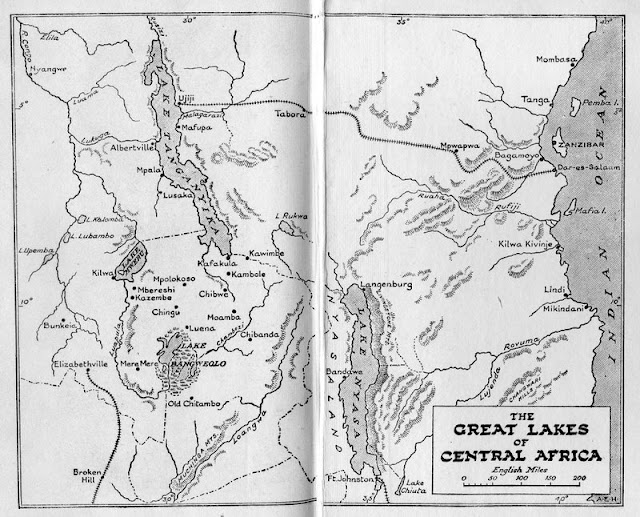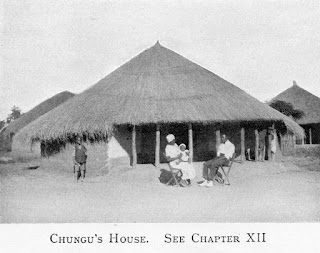This one goes out to Mutepa Kamoto who wrote telling me how his grandmother was headmistress at Mabel Shaw school, and mentioned his ancestor Kawandami who also worked at Mbereshi Mission. I guess this must be the same Kawandami mentioned (just once) at the start of this book. (
See also here for more on the school.)
This little book, Children of the Chief, written for children, and published by the London Missionary Society in 1921, tells the story of the beginnings of Mbereshi School for Girls (later Livingstone Memorial School) in Northern Rhodesia - the first school for girls in the colony and the main educational centre for Africans in the area at that time. At the time of writing, many people of the area remember David Livingstone fondly.
We hear of how Mabel Shaw daydreamed during her own schooling in England as the teacher spoke about the great lakes of the rift valley and then we are taken straight into the lives of the very first girls to attend the famous boarding school near Lakes Mweru, Bangwelu and Tanganyika. Based on other accounts, this must have been in 1915, when Mabel would have been about 25 years old. She was the first single woman missionary sent out by the LMS - the Mbereshi mission are waiting for her.
We hear how she went on the
Llandovery Castle to Cape Town, coming down the Thames in the dark, 'for it was the days of the great war'.
From Cape Town there is a train ride to Tiger Kloof where three days are spent at the 'native institution' there. From there the journey continues by train to Mafeking, Bulawayo, Victoria Falls and ends at Ndola, where Mabel is met by missionaries from Mbereshi who have walked for 3 weeks to meet her, along with 250 carriers to carry Mabel and luggage back to Mbereshi. One must imagine tables, chairs, baths, cooking utensils, and other provisions (such as tinned food, and coffee) being carried in a long train. Mabel will go by machila, trying hard to understand and be understood as the carriers do not speak English. All education at the school will be in Bemba. The carriers will often sing as they go. There is much amusement at how Mary crosses a tree trunk bridge over a river -- sitting and shuffling herself along.
There was already a boys' school at this time and there had been calls for a girls' school to be established also. Others remained to be persuaded that girls should also be educated. We hear the story from Mabel's point of view, of the first timid students, of parents afraid to leave their children in the boarding school with the white lady, of the children's growth as Christians and of how they were viewed by other children in Mbereshi village. They are called Children of the Chief,
bana ba Mfumu, the chief being God. They keep themselves somewhat apart from the other children in the village, are clothed modestly and try to keep to Christian principles. There isn't much told in this book of what they learned, but sewing is one activity and of course the girls learn to read and write, they sing hymns and doubtless are taught about the Bible and Christianity. They begin with 22 girls and later reach their full capacity of 30 pupils.
Here is a sketch of Mbereshi village. Apparently there was a leper camp at one end of the village. There were many leopards and people feared to go out at night or enter the forests alone.
After some time the older girls are given responsibility for the younger ones, becoming their 'mothers'. The youngest children are five years old.
A great treat is a picnic two hours walk away at Chitutawila. The missionaries' children must wear pith helmets and aren't allowed to splash in the river. Many girls suffer from malarial fevers.
During school holidays many girls walk (or if too young are carried) long distances to their home villages.
Once a year the missionaries of the area meet. For those at Mbereshi it means a 2 week journey.
It is not always clear whether first or last names are given, or who is depicted in the photographs.
Here are the names mentioned, most of which are girls who were part of the first girls' school class and boarded at the school with Mabel Shaw. You can guess the four young ones and the four older ones (who were the 'mothers'):
Beti (Betty), Chungu's baby
Chansa (five years old), one week walk to her home
Chileshye
Chiluba (cousin of Nellie, older girl)
Chipepa
Chishimba (niece of Mumba, Mporokoso / Mpolokoso)
Chulumanda (recommended girls should be taught, p17)
Chulunoma (watchman)
Chunda, Malita ('old, wrinkled, thin, tired, yet like a saint'), from Kawambwa
Chungu (older girl)
Fane (Fanny, older girl)
Gershom (baby)
Grey, Miss (Mabel Shaw's own teacher)
Kabombo (man, brings news of Sela's brother dying in Livingstone of influenza)
Kabwe, daugther of Maggie and Sumbukeni, in Chungu's group, mother lived near
Tanganyika
Kasembe's village - report of villages emptied by Arab slavers
Kayula
Kawambwa (camp on return from Kawimbe)
Kawandami (p.17) recommended girls should be taught
Kishya, aged 12, daughter of Malita
Leah (2 years old)
Lile (Lilly?)
Lisi (Lizzie)
Lutina, Mary (5 years old)
Maggie, slave girl of Mwenya Shimwango, taken to Mbereshi by missionaries
Mapoma (carrier)
Mayo (?)
Meli (from Kawimbe? brought to meet them on journey from K to Mbereshi)
Monica (daughter of doctor missionary)
Mulenga (frail, lame girl)
Mulengo, Mary (5 years old)
Mulongoti (carrier)
Mumba, uncle of Nellie
Mupelwa (helped in Mary's big house, older girl) from Kawimbe by Tanganyika
Musonda
Mutiampa (his grandfather met D Livingstone)
Mwamba (lame girl)
Mwenya, Shimwango's wife, would sleep in dormitory with girls
Nakisitu
Ndola (girl) - 1 week walk to her home
Nellie, daughter of Chulumanda, cousin of Chiluba
Nsama (niece of Mumba, from Mporokoso)
Pule
Sarah
Sela
Semba
Shimwango (headman, Lake Tanganyika somewhere)
Sumbukeni (teacher at Mbereshi), Maggie's husband
Timothy, Sela's oldest brother, from Chiengi village, went to Tiger Kloof, ran Mbereshi school for some weeks, died of influenza
Truda (younger daughter of doctor missionary, sister of Monica)
Hymns
Church goers will recognise hymns they sang:
All people that on earth do dwell
Abide with me
There is a city bright
We are all little children weak
When he cometh
References
The School of Oriental and African Studies in London has records of the LMS
JSTOR carries some relevant journals.
Brief biography of Mabel Shaw
http://www.mundus.ac.uk/cats/4/915.htm
See also
http://www.jstor.org/discover/10.2307/219137?uid=3738032&uid=2129&uid=2&uid=70&uid=4&sid=55958895503
An excellent article is "No girl leaves school unmarried" by Sean Morrow in the Journal of African Studies. More another day.


















